People
‘People Are Too Stupid for Great Art’: Painter Markus Lüpertz on Why the Avant-Garde Will Always Fail
The controversial German painter currently has three US exhibitions.
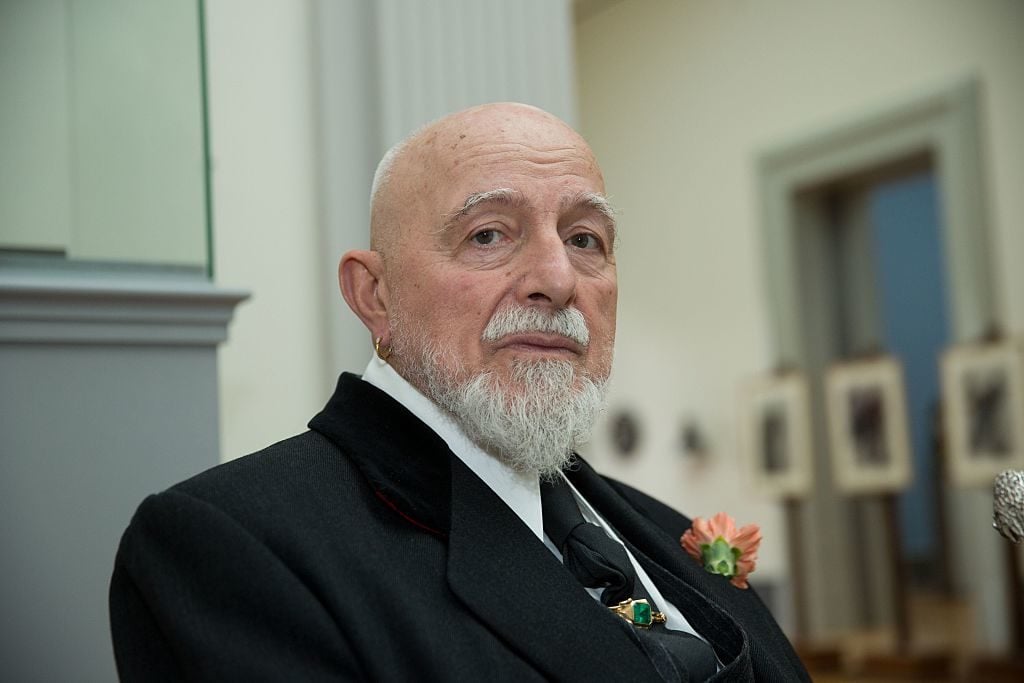
The controversial German painter currently has three US exhibitions.

Henri Neuendorf

Over the course of his five decade career, Markus Lüpertz has cultivated and embraced his public image as a modern-day dandy almost as much as his reputation as a highly divisive artist and serial provocateur. This, of course, has made him a star in his native Germany where the tabloid press regularly lauds him as a “lord of painting.”
Lüpertz emerged amongst a generation of post-war German artists in the 1960s that grappled with finding a stylistic approach that relied on neither figuration nor abstraction. This translated into a series of “dithyrambic” paintings consisting of figurative elements interspersed with abstract blocks of color. Deeply suspicious of the populist and fascist connotations of figurative art, and yet dissatisfied with coat-tailing American abstract expressionism, Lüpertz and his contemporaries, such as A.R. Penck, Georg Baselitz, and Gerhard Richter, welcomed the challenge of pursuing a unique blend of abstract figuration.
His willingness to engage with controversial subject matter, especially on the difficult topic of Germany’s fascist past, has made him a controversial figure—although his subsequent work became more tempered by increasingly diverse influences ranging from fashion, landscape, and still life. His most recent work, however, appears lyrical, laden with imagery based on classical and mythological references.
It’s an important time in Lüpertz’s career, as he’s finally getting the recognition in America that he’s long enjoyed in Europe. The show at Michael Werner Gallery is one of three exhibitions currently on view, including two museum exhibitions: one at the Hirshhorn Museum and the other at the Phillips Collection.
Ahead of the opening of Lüpertz’s exhibition at Michael Werner, we caught up with the artist and spoke to him about America’s new interest in his work, and the missteps of contemporary art.
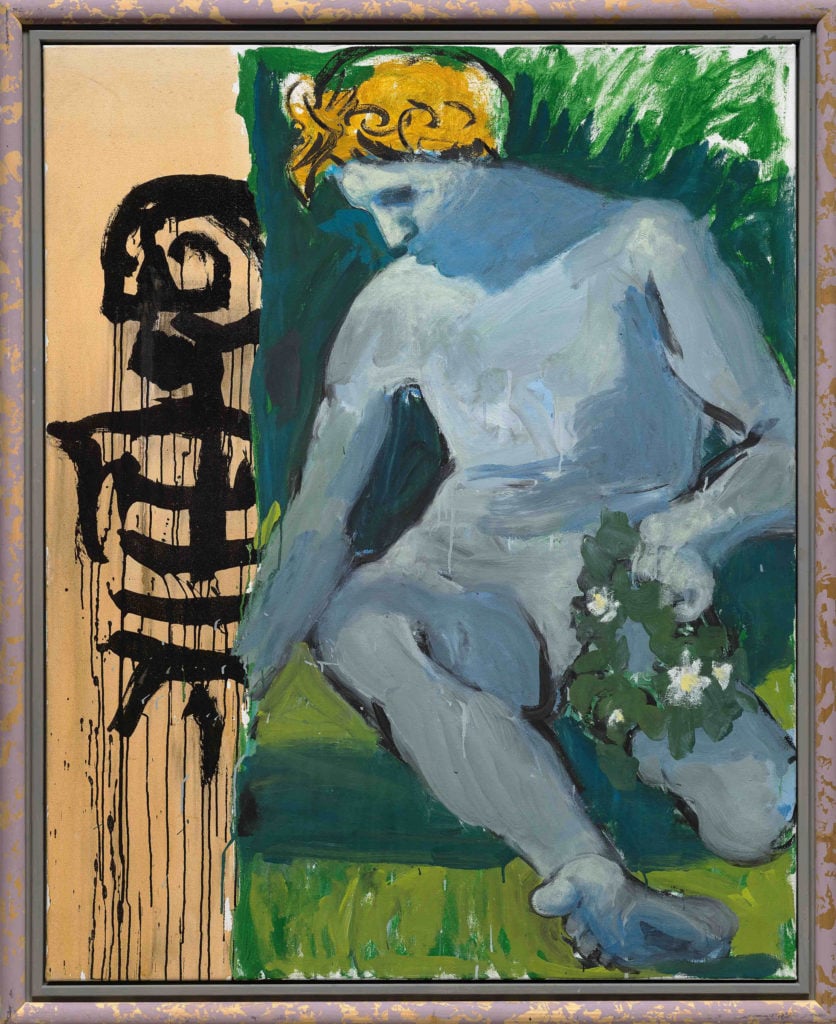
Der Grosse Narziss (The Great Narcissus), 2016. Image courtesy Michael Werner Gallery.
You are part of an extraordinary generation of German painters that emerged in postwar Germany. How do you explain this cumulative creative spark during this period, especially in the ’60s and ’70s?
I think it was an answer to the repression of the development of visual art under the Nazi dictatorship. But art and painting can’t be killed, and it continued abroad. So I think, for us, it was a taking back of a significant and important position in painting.
How do you recall your encounters with painters like A.R. Penck, Georg Baselitz, and Gerhard Richter at Michael Werner Gallery in the 1970s?
It was a strange time, a time of discovery. Michael Werner was tight with Baselitz and they discovered artists. At the time Antonius Höckelmann was part of the group, and Anselm Kiefer and Jörg Immendorff came later. And then at some point Michael and I met at this exhibition space called Grossgörschen, a gallery for painters that I founded. Actually he met my wife first, and later ended up marrying her—but that’s another story.
He approached me and then wrote to Baselitz that he met this crazy painter—which was me—and that’s how I met Baselitz, with whom I developed a very close and deep friendship. This in turn led to friendships with Höckelmann, Penck, and also later Kiefer and Immendorff. It was very important to me to be part of a group, which I looked at as a cast of ambitious warriors.
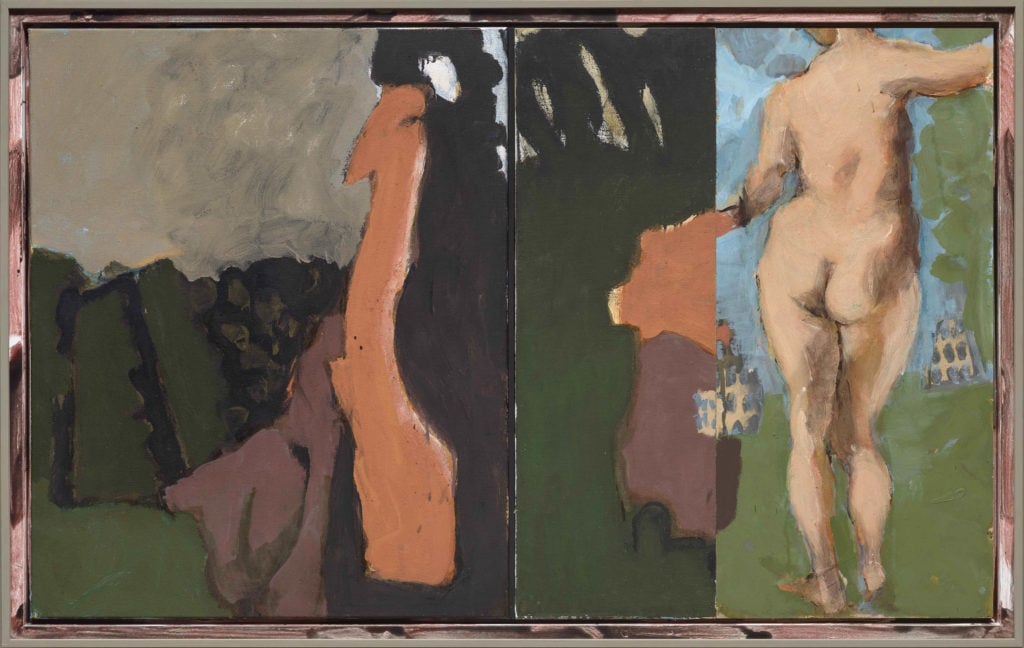
Markus Lüpertz Kolbermoor, 2017. Image courtesy Michael Werner Gallery.
To what extent does your work in sculpture, poetry, and music influence your painting?
Sculpture is part of painting, I wouldn’t separate the two. There’s a term called “painter’s sculpture” that has a long tradition and was practiced by Degas, Matisse, Picasso, and the expressionists Beckmann and Kirchner—even Modigliani made sculptures. There’s a long tradition of painters trying to portray their paintings as physical objects.
Painters have a totally different perspective on sculpture than sculptors do. The sculptor makes sculptures, but we make figures out of pictures. It doesn’t matter whether they’re abstract or figurative, we transfer the deformation of painting into sculptures. And we work with flat perspective. We look at sculpture as a relief. Even a full sculpture is always crafted from multiple surfaces. That’s the difference, and that’s why I wouldn’t separate sculpture from painting. I think that the three basic disciplines of visual art: drawing, painting, and sculpture are all very important to the painter. Immendorff, Penck, de Kooning, they all made sculptures. Baselitz makes fantastic sculptures.
But today there are almost no sculptors left, except maybe Tony Cragg. But everyone’s preoccupied with events now. So it’s up to the painters to ensure that sculpture continues to live.
Can you explain how you developed your unique abstract figurative painting style?
We came into a world where abstraction was a must, and we started to develop our oeuvre at the time when Art Informel was the leading visual language. Although we were certainly influenced by Informel, we had a different yearning, different ambitions. I’ve claimed to be an abstract painter my whole life, but pure abstraction is very limited. You can make squares and kidney shapes, but even if you do it differently every time, it’s still the same. And these limitations of abstractions were filled with figures by us.
We’re lucky to practice painting in its purest form. We’re not bound thematically. That’s the greatest mistake many painters have made, even today’s painters. They think they have to approach painting academically or politically. That’s all nonsense and it doesn’t preoccupy the painter. Abstraction was as an outstanding discovery, and we combined this abstraction with figuration, and that was a dimension that had never existed before in art.
In this moment—if everyone painted, and if everyone was more intelligent—we could all paint the greatest pictures, because we have unparalleled freedom. But nobody accepts it. Only us old sacks of shit live with it. But the youth isn’t interested. They’d rather save the world from extinction, or stop the poles from melting—that’s all nonsense.
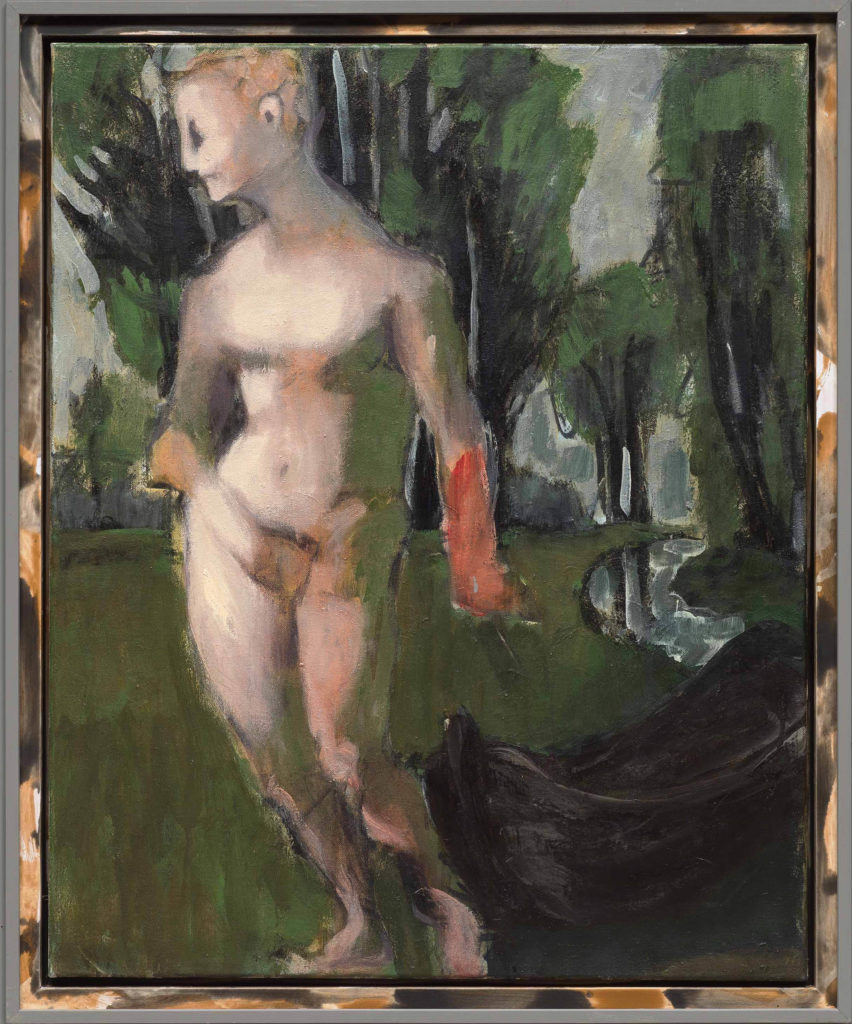
Markus Lüpertz Medea, 2017. Image courtesy Michael Werner Gallery.
What do you mean when you say freedom?
That we can paint whatever we want! We’re inventors of titles, inventors of themes. We’re critics. We have to do it all ourselves, because there is no philosophy over painting, no ideology, unless you yourself are a painter. And seeing that almost nobody paints anymore, that responsibility lies with the artists.
Contemporary art, which includes events, photography, and so on, are honorable activities and are all fine and well, but it’s not painting. And the one thing I accuse theses events of—and it’s not the artists’ fault—is that they abolish painting in people’s minds because it’s much easier to look at a photo than to look at a painting.
What are you referring to when you say “events”?
By events I mean installations. Take the Venice Biennale, for example. The woman [Anne Imhof] who locked up the dogs, that’s fantastic. It could be art, I don’t know. It’s certainly an amusing event, admittedly a little boring, but I’ve experienced that sort of thing before.
I refuse to criticize it, but these new things are different. And in visual art there is nothing new, there’s only new painters and that’s the exciting thing about painting: The vocabulary is fixed. You can’t do anything differently, whether it’s Baselitz or me there is no difference. All we can do is put a brush to a canvas. Caravaggio couldn’t do anything differently. The individual aspect of art is the artist. There’s always new artists that interpret the vocabulary of painting in their own way, and that’s the exciting and wonderful part of painting.
The new is the avant-garde, but the avant-garde destroys art. Today’s museums are like: “Aaaah, look, there’s half a man peeking out from the floor, there’s horse hanging somewhere, here’s a mattress rotting in the corner. It’s wonderful, right?”
You’re often viewed as a controversial figure—especially in Germany—because of your willingness to address difficult subjects, both in the content of your work and the press. How do you deal with that perception?
I can’t really comment on my reputation because the reputation is in no way justified. I’m a peaceful, happy, cheerful, elderly gentleman, except for the fact that I like to be argumentative.
When I present public artworks there’s always someone who’s against it. I heard that my sculpture was tarred and feathered in Salzburg, for example. What should I say about that? If I was there I’d have punched him in the head, but being that I wasn’t, there’s nothing I can do. Nobody touches my work in my presence or else I’ll beat him to death. That’s just my nature. I don’t care if it’s the emperor of China or if it’s Arnold Schwarzenegger, I’ll come from behind with an iron rod. I’ll get him down.
But that’s not the problem. My concern isn’t to provoke people, my concern is to deliver quality, that’s all I can do. Sometimes it makes me feel ill, or unloved. I put all my passion and commitment into it, at the very least you should respect my work, even if you don’t like it. But people are too stupid for art, for great art. You can write that in bold letters: The people are too stupid for great painting.
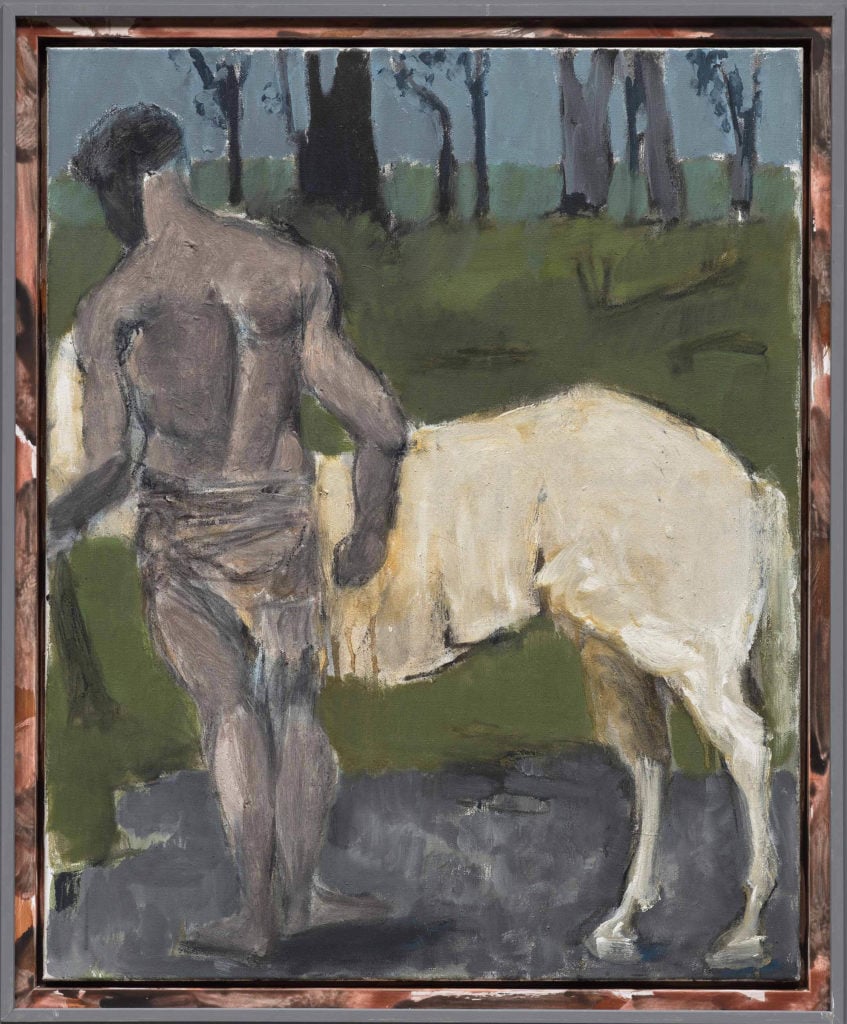
Markus Lüpertz Geburt des Centaur (Birth of the Centaur), 2017. Image courtesy Michael Werner Gallery.
What is the role of art in today’s society?
Art is part of society. As artists we belong to society, because a society is judged by the art it produces. The present can’t judge art. It can love or reject art, but nobody can say what great art is at this moment.
History has taught us what great painting is. During Hans Makart’s time in Vienna, the people wanted to be like Makart. They dressed like Makart, they lived like Makart. Everyone had to have a Makart. And today nobody remembers him.
The present is often wrong. It can be right in error, but it can also be wrong. There is no truth in the present, only affection, love, and rejection. Artists fight for this love to sustain themselves, but they also live with rejection.
The present is like a marriage. I don’t think an artist, a gallerist, or a collector can understand the art made during his time. They can only love or hate it. Unfortunately, I attract more hate than love, but that’s probably for other reasons.
What is the role of the artist in society?
The artist has nothing else to do except make art—that’s all. In the same way that the carpenter makes tables, or the fabricator who makes his money. The painter belongs to society in the same way, but painting makes the artist unique, because it’s a unique and exceptional occupation.
Artistic ability comes from God, it doesn’t come from the necessity of everyday life, its existence is part of our spiritual dimension that society has to carry and endure.
We live in an unprecedented political time in the United States, but also in Europe and across the world. What responsibilities do artists have under these circumstances?
None at all. Society is responsible for art and for peace, and that we’re educated enough to understand art. But society makes mistakes. We’re vehemently approaching a war and democracy has only made people stupid.
Society has not taken its responsibilities seriously, but the artist has no responsibilities. I’m not an academic, I’m not here to save the world. I am only here to promote liberalism, generosity, and no racism or hate. Art is a wonderful catalyst for these things because art is pure, art teaches people to be better, greater, and more beautiful. That is its purpose. Not academia, not politics, these things only deride artists and annoy me terribly. Every artist that has let himself or herself into politics has promptly been betrayed by the politicians. Nobody’s survived it.
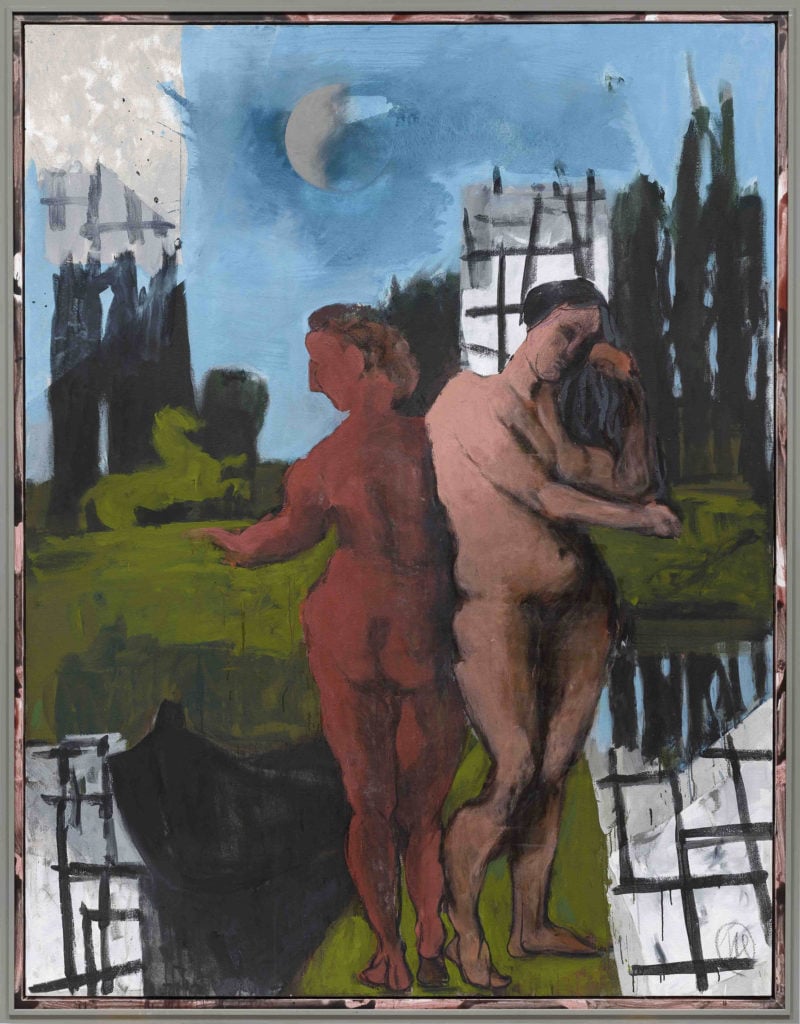
Markus Lüpertz Morgenrot (Red Dawn (2017). Photo: Michael Werner Gallery.
You currently have three exhibitions in the U.S., two in Washington, D.C. at the Phillips Collection and the Hirshhorn Museum, and one at the Michael Werner Gallery in New York. How have American audiences interpreted your work?
In America, myself and other German painters are regaining momentum. We all had a boom in America and then that went away again, with a couple of exceptions like Baselitz, Richter, and Polke who’ve remained popular. Myself, Immendorff, and Penck, we all faded away a little in America—although we didn’t disappear. But now that’s changed again, it goes up and down all the time.
At this moment I’m noticing that at certain exhibitions, art fairs, and so on, America has once again developed a curiosity in my work. But these are things that are very difficult to influence as an artist.
Do you think Americans understand your work differently than Germans?
Yes, because they have a different social structure. What Americans see in my painting is certainly different than what Germans see, because each have different origins. We have this horrible 1,000, 2,000, or 3,000-year-old culture—American painters don’t have that. They’re like tourists. They come to Europe and think it’s all great, but we have to live with it. We have it in our blood. We’re predestined for great painting, much more than other generations.
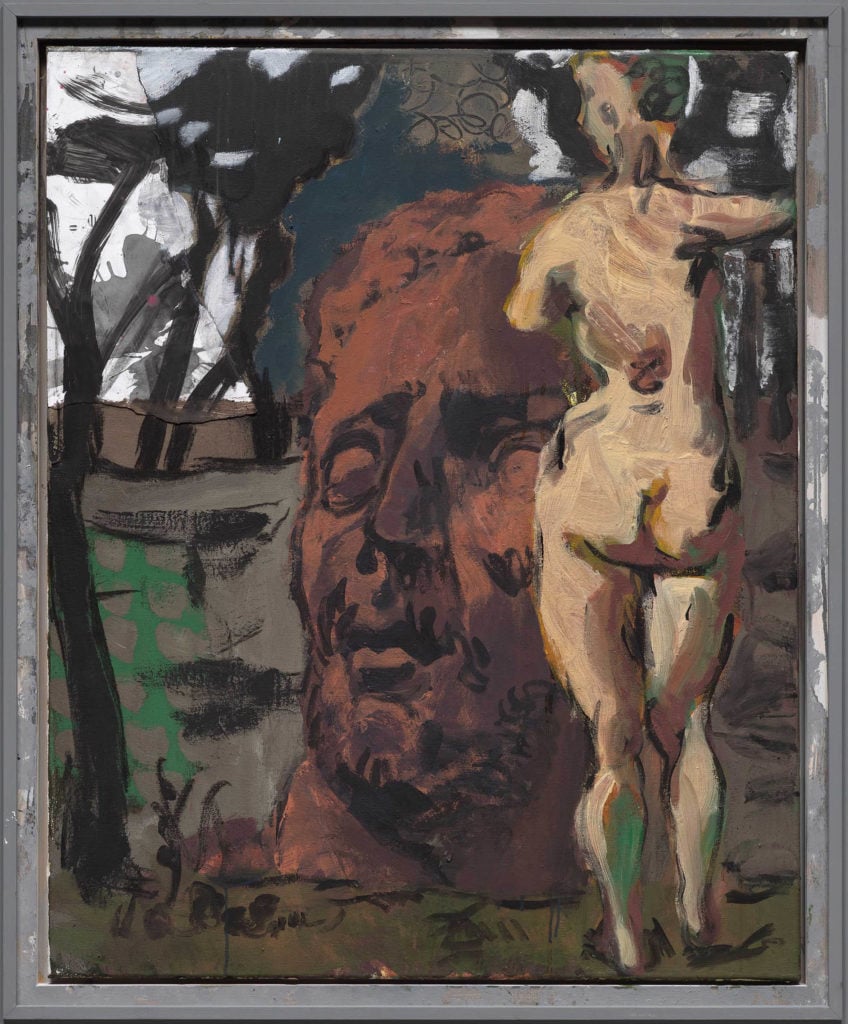
Markus Lüpertz Orakel (Oracle), 2017. Image courtesy of Michael Werner Gallery.
Do you think Germany has a special relationship to painting?
It did, up until the 1970s. People used to automatically speak of art as sculpture and painting, and nothing else—but that was long ago.
How did that change come about?
Because of the media. We live in a world that is preoccupied with hysteria, there’s no more time for painting. For painting you need independent creativity, and that doesn’t exist anymore. If somebody tells you something that’s no longer good enough, people take out their phones and have to show you.
A man no longer tells his friend, “My wife is so beautiful, her hair shines, and her eyes glow, and her lips are like a chalice from which I drink.” People don’t say that anymore. He’ll say, “I bagged this great woman, wanna see?” And turn on his phone.
This generation doesn’t have the imagination to perceive something unless they’ve photographed it. If you go to see the Mona Lisa at the Louvre the people all have their phones out—they don’t even look at the picture.
In fairness it’s not that special, there’s much better portraits, like Vermeer’s Girl With a Pearl Earring; that’s a wonderful picture. I think about that every time they hype the Mona Lisa with her stupid grin. It’s incredibly annoying. But Girl With a Pearl Earring, my god that’s a wonderful picture. Captivating. It makes me weep when I look at it.
“Markus Lüpertz: Threads of History” is on view at the Hirshhorn Museum, Washington, D.C., May 24–Sept. 10, 2017; “Markus Lüpertz” at the Phillips Collection,Washington, D.C., May 27–Sept. 20, 2017; and “Markus Lüpertz: New Paintings” is on view at Michael Werner Gallery, New York, May 18–July 7, 2017.